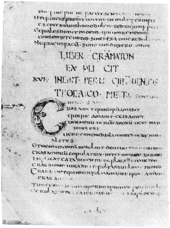Pervigilium Veneris


Pervigilium Veneris (or The Vigil of Venus), is a Latin poem of uncertain date, variously assigned to the 2nd, 4th or 5th centuries. It is sometimes thought to have been by the poet Tiberianus,[1] because of strong similarities with his poem Amnis ibat, though other scholars attribute it to Publius Annius Florus, and yet others find no sufficient evidence for any attribution.[2][3] It was written professedly in early spring on the eve of a three-night festival of Venus (probably April 1–3) in a setting that seems to be Sicily. The poem describes the annual awakening of the vegetable and animal world through the "benign post-Lucretian" goddess,[4] which contrasts with the tragic isolation of the silent "I" of the poet/speaker against the desolate background of a ruined city, a vision that prompts Andrea Cucchiarelli to note the resemblance of the poem's construction to the cruelty of a dream.[5] It is notable because of its focus on the natural world – something never before seen in Roman poetry – which marks the transition from Roman poetry to Medieval poetry. It consists of ninety-three verses in trochaic septenarius, and is divided into strophes of unequal length by the refrain:
Cras amet qui nunquam amavit; quique amavit cras amet.
Let him love tomorrow who has never loved, and let him who has loved love tomorrow.
The poem ends with the nightingale’s song, and a poignant expression of personal sorrow:
illa cantat; nos tacemus; quando ver venit meum?
She sings; we are silent; when will my springtime come?
English verse translations
There are translations into English verse by the 17th-century poet Thomas Stanley (1651); by the 18th-century "graveyard school" poet Thomas Parnell (1679-1718); by Sir Arthur Quiller-Couch in The Vigil of Venus and Other Poems by "Q"; by F. L. Lucas (1939; reprinted in his Aphrodite, Cambridge, 1948); and by Allen Tate (1947; see his Collected Poems).
Musical settings
The poem has appealed to 20th-century composers and has been set to music by Frederic Austin for chorus and orchestra (first performance, Leeds Festival, 1931); by Timothy Mather Spelman, for soprano and baritone solo, chorus and orchestra (1931); by Virgil Thompson as "The Feast of Love", for baritone and chamber orchestra, text translated by himself (1964); and by George Lloyd for soprano, tenor, chorus, and orchestra (1980).
Modern editions
- Editio princeps (1577)
- Franz Bücheler (1859)
- Alexander Riese, in Anthologia Latina (1869)
- E. Bahrens in Unedierte lateinische Gedichte (1877)
- S. G. Owen (with Catullus) (1893)
- D. R. Shackleton Bailey in volume six of the Loeb classical library: Gaius Valerius Catullus, Tibullus and [Tiberianus] Pervigilium veneris, G. P. Goold, editor, translated by Francis Warre Cornish, John Percival Postgate, John William Mackail, second edition, revised (Harvard University Press, 1988)
- Andrea Cucchiarelli. La veglia di Venere. Pervigilium Veneris in BUR Classici Greci e Latini. Biblioteca Universale (Milano: Rizzoli, 2003) ISBN 88-17-10635-6. Paperback. With notes and facing translation in Italian. This new edition, with Latin text based largely on Shackelton Bailey, includes a brief anthology of commentary – from Voltaire to contemporary criticism (pp. 51–60) and an up-to-date bibliography (pp. 61–72). There is also an appendix (pp. 155–65) of texts and Italian translations of some of the most famous poems of late antiquity devoted to the theme of the rose – many from the so-called Latin Anthology, a collection of poems from the imperial age thought to have been assembled at Carthage "during the cultural renaissance of Vandalic Africa in the 5th century CE. This appendix highlights the vitality of the rose topos and of the symbolism associated with it, which spread from the ancient world into European literature of all ages, and it offers the reader a welcome opportunity for reading and appreciating, this time in an Italian translation, a series of poems scarcely studied or known."[6]
 This article incorporates text from a publication now in the public domain: Chisholm, Hugh, ed. (1911). Encyclopædia Britannica (11th ed.). Cambridge University Press.
This article incorporates text from a publication now in the public domain: Chisholm, Hugh, ed. (1911). Encyclopædia Britannica (11th ed.). Cambridge University Press.
References
- ↑ About the poet Tiberianus and about his hymn to the deus omnipotens cf. Francesco Perono Cacciafoco, Sincretismo filosofico-religioso e tradizione nell'inno al deus omnipotens di Tiberiano, in «Atene e Roma», n. s. II, VI 1-2 (2012), pp. 90-110, link paper.
- ↑ On the text see John William Mackail in Journal of Philology (1888), Vol. xvii.
- ↑ Korhonen, Kalle (2012). "Sicily in the Roman Imperial period: Language and society". In Tribulato, Olga. Language and Linguistic Contact in Ancient Sicily. Cambridge: Cambridge University Press. p. 360. ISBN 9781107029316. Retrieved 2 May 2014.
- ↑ "la benigna dea post-Lucreziana" (i.e., the Venus genetrix derived from Lucretius's De Rerum Natura), see Andrea Cucchiarelli, La Veglia di Venere: Pervigilium Veneris (Milano: BUR Classici Greci e Latini, Rizzoli: 2003), p. 7.
- ↑ Cucchiarelli (2003), p. 7.
- ↑ Tiziana Privitera, Bryn Mawr Classical Review, June 3, 2004 On the Carthaginian so-called "Latin Anthology", see also Andrew H. Merrills, Vandals, Romans and Berbers: new perspectives on late antique North Africa (Ashgate, 2004)., pp. 110 and passim.
External links
| Wikiquote has quotations related to: Pervigilium Veneris |
- The Pervigilium Veneris. A Latin text
- An offered translation (Blackwood's Edinburgh Magazine, June 1843)
- Translation by David Camden
- Carol Rumen's Poem of the week: Pervigilium Veneris, "Thomas Parnell's translation of The Vigil of Venus, a sensuous celebration of the arrival of spring". The Guardian (UK, March 21, 2011)